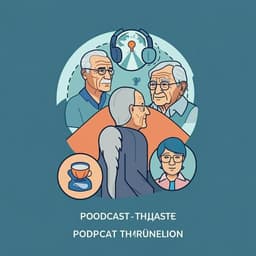
Physics
Rapid onset of molecular friction in liquids bridging between the atomistic and hydrodynamic pictures
A. V. Straube, B. G. Kowalik, et al.
This groundbreaking research by Arthur V. Straube, Bartosz G. Kowalik, Roland R. Netz, and Felix Höfling delves into the atomistic origins of friction in liquids. By examining water, a Lennard-Jones fluid, and a supercooled mixture, the study uncovers the sudden onset of friction and its implications for understanding the mechanical properties of soft materials.
~3 min • Beginner • English
Introduction
The study investigates how molecular-scale, time-reversible dynamics governed by Newton’s equations give rise to macroscopic friction and dissipation in liquids. While Stokes’s law links steady-state friction to viscosity and extends to dynamic friction ζ(ω) at low frequencies, the atomistic origin and frequency-resolved onset of friction have remained elusive. Non-Markovian Brownian motion and viscoelastic features are known in complex fluids, yet direct evidence of how friction emerges from conservative interactions at molecular scales was lacking. This work aims to bridge atomistic and hydrodynamic descriptions by measuring ζ(ω) across broad frequency windows for representative liquids and to elucidate when and how dissipation appears, whether high-frequency response is elastic, and how single-particle friction relates to macroscopic viscoelasticity via the generalised Stokes–Einstein relation (GSER).
Literature Review
Classical hydrodynamics (Stokes, 1851) predicts frequency-dependent friction for oscillatory motion and hydrodynamic memory; recent experiments confirmed these effects for micron particles. Microrheology relates ζ(ω) to viscoelastic properties of complex fluids. From a microscopic viewpoint, liquids follow conservative dynamics with smooth, time-reversible trajectories, making the emergence of friction and entropy production subtle. Prior theoretical frameworks (Zwanzig–Mori projection) relate Liouville dynamics to dissipation spectra but require approximations; short-time expansions predict zero friction to all orders, highlighting non-locality in time. Sum rules constrain spectra but ad hoc models can violate them. Hard-sphere fluids introduce instantaneous, Markovian friction via collisions, obscuring the frictionless regime. Hydrodynamic long-time tails (t⁻³/²) are established in simple liquids, while under supercooling and in complex environments other power laws (t⁻⁵/²) appear. The GSER is widely used in microrheology to connect probe friction to bulk viscoelasticity but its general validity, especially for molecular liquids and across frequencies, is debated.
Methodology
- Strategy: Use equilibrium molecular dynamics (MD) to compute mean-square displacement (MSD) and derive both dynamic friction ζ(ω) and memory function γ(t) without model ansatz, employing fluctuation–dissipation links. Cross-validate via two independent routes: (i) a Fourier–Laplace (frequency-domain) path with an adapted Filon algorithm and (ii) a time-domain deconvolution from the velocity autocorrelation function (VACF).
- Data-analysis pipeline (Fig. 2):
1) From MSD(t), compute time-dependent diffusivity D(t)=∂t MSD/6 and VACF Z(t)=½ ∂t² MSD.
2) Frequency route: Apply an adapted Filon quadrature to sparsely sampled correlation data to obtain Fourier–Laplace transforms with controlled high-frequency behavior and smooth long-time truncation. Compute the generalized mobility ẏ(ω) via fluctuation–dissipation and the memory kernel ŷ(ω). Obtain ζ(ω)=m Re ŷ(ω). Inverse cosine transform yields γ(t).
3) Time-domain route: Solve the Volterra equation for momentum relaxation, Z̈(t)=−∫₀ᵗ γ(t−s) Ż(s) ds, recast into an integral equation for G(t)=∫₀ᵗ γ(s) ds and solve on a uniform time grid using a stabilized predictor–corrector deconvolution (trapezoidal recursion). Differentiate G(t) to get γ(t). Compare with the frequency-route result for cross-validation.
- Theoretical framework: Use complex analysis properties of correlation functions (Herglotz–Nevanlinna type), exact sum rules, and Kramers–Kronig relations. Short-time smoothness implies finite spectral moments and thus exponential high-ω decay of dissipative spectra. Hydrodynamic long-time tails (e.g., Z(t)∼t⁻³/²) dictate small-ω non-analyticities and corresponding power laws in γ(t) and ζ(ω).
- Viscosity spectra: Compute shear-stress autocorrelation Cη(t) in NVE runs; obtain η(ω) from its Fourier–Laplace transform (Green–Kubo). Compare ζ(ω) to 6πa Re η(ω) (GSER), fixing a so that ζ(0)=6πaη₀.
- MD systems and conditions:
• Liquid water: GROMACS 5.1, SPC/E model; 3007 molecules in L=4.49 nm cubic box; 300 K, 1 bar. NVE for correlation functions over 275 ps with 1 fs timestep, double precision. η(ω) from additional NVE totaling 49 ns.
• Lennard–Jones (LJ) mono-atomic liquid: HAL’s MD; NVE, 10⁵ particles, U(r)=4ε[(σ/r)¹²−(σ/r)⁶], cutoff 2.5σ; ρ=0.8 σ⁻³, kBT=1.3 ε; time unit τLJ=(mσ²/ε)¹ᐟ². Dynamic correlations sampled on sparse grids with smoothly truncated potentials to minimize drift.
• Supercooled liquid: Kob–Andersen 80:20 binary LJ mixture, 64,000 beads, ρ=1.2 σ⁻³, T*=0.6 (near MCT onset), tracing larger species; equilibration ~9000 τLJ.
• Control (pinned cage): LJ fluid with all but one particle pinned to form immobilized cages; single mobile particle trajectories averaged over ~10⁶ distinct cages after equilibration; MSDs recorded to isolate cage-rattling dynamics.
- Numerical details: Adapted Filon integrates piecewise exponential interpolants between irregular time samples with exponential long-time truncation, preserving short-time polynomial behavior by fitting in t²; time-domain deconvolution stabilized by predictor–corrector averaging. Both routes tested against an analytically solvable VACF model Z(t)=[1+(t/τ)²]⁻¹ to verify exponential high-ω decay and power-law tails.
Key Findings
- Rapid, exponential onset and suppression of friction at high frequencies: Across water, LJ, and supercooled liquids, ζ(ω) drops exponentially to zero beyond a characteristic molecular frequency ωc. Above ωc, liquids respond elastically (non-dissipative), consistent with a finite high-frequency modulus.
- Liquid-specific mid- and low-frequency behavior:
• Water: ζ(ω) exhibits a local maximum near ω/2π ≈ 5 THz, then slowly approaches ζ0, reaching it around ≈0.1 THz. The mobility Re ẑ(ω) peaks at ≈1.3 THz with ≈2.5× enhancement over the macroscopic mobility 1/ζ0.
• LJ liquid: ζ(ω) varies smoothly with a global maximum at intermediate ω and approaches ζ0 from above with the hydrodynamic √ω singularity (Stokes small-ω asymptote). The VACF shows the classic long-time tail Z(t)∼t⁻³/².
• Supercooled liquid: Clear separation of time scales—rapid friction onset followed by slow hydrodynamic emergence separated by roughly three decades in time. Mobility enhancement near ωc is substantial (~30× over 1/ζ0). Memory shows a long-lived positive plateau with logarithmically slow decay.
- Memory functions and correlations: γ(t) universally exhibits a quadratic short-time decay, followed by oscillations and power-law tails inherited from Z(t) with opposite sign (e.g., t⁻³/² for LJ; t⁻⁵/² for water and supercooled). This indicates persistent Brownian force correlations across wide time windows.
- Non-locality of friction: Due to smooth, time-reversible trajectories, Taylor expansions of Z(t) yield zero dissipative contribution at all orders; hence friction arises from non-local-in-time properties. Exact sum-rule arguments enforce exponential high-ω decay of Re spectra.
- Physical mechanism for onset: Control simulations with a single particle in a frozen cage reproduce the high-ω behavior of ζ(ω), implicating rapid, irreversible momentum transfer to neighboring molecules during cage rattling as the driver of friction onset. Deviations at low ω (e.g., Im ŷ(ω)∼1/ω, ζ(ω)∼1/ω²) reflect confinement and absence of hydrodynamics.
- GSER assessment (ζ(ω)=6πa Re η(ω)):
• LJ (Newtonian): GSER fails—ζ(ω) and η(ω) spectra differ markedly; Re η(ω) is hydrodynamically flat at low ω while ζ(ω) follows Stokes’s dynamic correction; elastic parts are dissimilar.
• Water: GSER provides a reasonable qualitative description up to ≈2 THz; friction and viscosity share spectral features including elastic parts, though not perfectly.
• Supercooled: GSER nearly quantitative over a broad frequency window, with elastic components collapsing (Im ẑ(ω)≈Im η(ω)) showing similar apparent power-law scaling (ω⁻⁰·⁷⁵). Breakdown at large ω where collective response lacks the single-particle elastic peak.
- High-frequency elasticity: Data confirm liquids behave as elastic solids at high ω with non-zero storage modulus, in line with Frenkel’s picture; Maxwell-type models fail at high ω (predict power-law Re η decay instead of exponential).
Discussion
The work demonstrates how dissipation emerges from atomistic, conservative dynamics: friction appears abruptly at a molecular frequency ωc due to fast, irreversible momentum transfer during cage rattling, while its detailed onset is influenced by slow hydrodynamic processes via Kramers–Kronig coupling. Exponential suppression of ζ(ω) at high ω and concomitant elastic response answer the central question of when a liquid behaves frictionlessly versus hydrodynamically. The intricate memory functions reveal long-lived Brownian force correlations, underscoring the fundamentally non-Markovian nature of molecular motion. Testing GSER across systems shows it is not universally valid: it fails for simple Newtonian liquids, is qualitatively useful for water, and nearly holds in a moderately supercooled liquid over substantial frequency ranges. These findings refine the connection between single-particle dynamics and macroscopic viscoelasticity, guiding interpretation of microrheology and suggesting limits of continuum-based models at molecular scales.
Conclusion
This study bridges atomistic and hydrodynamic descriptions by mapping molecular friction ζ(ω) across frequencies for three prototypical liquids. Key contributions include: (i) establishing an exponentially rapid onset of friction at a characteristic frequency ωc, above which liquids exhibit purely elastic, non-dissipative response; (ii) identifying irreversible, fast momentum transfer to cages as the mechanism for friction onset; (iii) quantifying complex, persistent memory functions of Brownian forces; and (iv) critically evaluating the GSER, revealing failure in Newtonian fluids, qualitative validity for water, and near-quantitative agreement in a supercooled liquid. The methodology—ansatz-free extraction of ζ(ω) and γ(t) from MSD/VACF using robust transforms and deconvolution—extends to other soft-matter and glassy systems and to microrheology data analysis. Future directions include: rigorous links between frequency-dependent transport and the Lyapunov spectrum; systematic frequency-resolved GSER tests deeper into supercooling to disentangle contributions of fast vs slow processes to Stokes–Einstein violations; incorporation of exact high-ω constraints into microscopic theories; and application to heterogeneous environments and interfacial flows.
Limitations
- Scope limited to three model systems (SPC/E water, simple LJ liquid, Kob–Andersen mixture); generality to other chemistries and interaction potentials remains to be tested.
- Reliance on classical MD and specific force fields (e.g., SPC/E) may affect quantitative details at very high frequencies; quantum and polarizable effects are not included.
- Hydrodynamic long-time tails are not clearly visible for water and the supercooled liquid due to small prefactors, limiting direct verification of some asymptotes in those cases.
- GSER assessment depends on defining an effective probe radius a from ζ0=6πη0 a; such mapping may be non-unique in molecular systems.
- The proposed link to microscopic chaos (e.g., Lyapunov exponents) is speculative and not quantified here.
- Control simulations with pinned cages isolate fast momentum transfer but remove collective hydrodynamics, limiting low-frequency comparisons.
Related Publications
Explore these studies to deepen your understanding of the subject.







